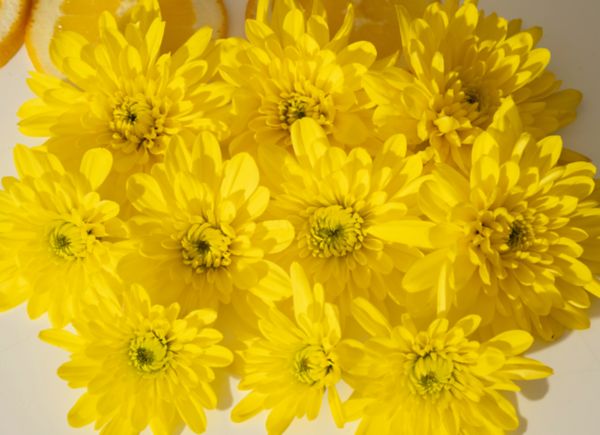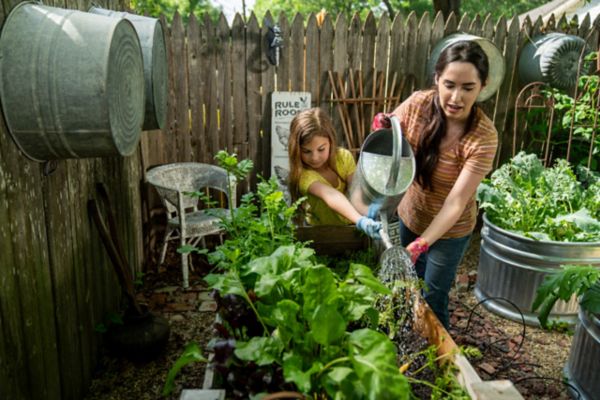How to Grow Chrysanthemums
Authored by Leah Chester-Davis
Just when you start saying goodbye to summer annuals and perennials, perhaps growing a bit wistful about the waning of favorite plants, mums burst onto the scene. With a wide-ranging color palette of blooms that come in many different styles and shapes, mums are perfect for the fall season.
Chrysanthemums, mums for short, are available year-round but there is no doubt these are favorite fall plants. They are members of the aster or daisy family, and their jewel-toned colors like deep amethyst, garnet, gold, and amber add a rich dimension to any fall garden, particularly paired with the colorful autumn tree foliage. There is also a wide selection of whites, creams, pinks, lavenders, yellows, oranges, and bi-colors.
They grow as clump-type plants with upright or sprawling stems, and there are numerous species and varieties. The National Chrysanthemum Society, USA, categorizes mums into several different classes based on the shape and arrangement of the petals. Mums can even be grown into bonsai, sprays, trees, or cascading forms.
About mums
| Botanical name: | Chrysanthemum x morifolium |
| Common name: | Chrysanthemums or Mums |
| Plant type: | Herbaceous perennial; often used as a fall annual |
| Size: | 1 ½ to 3 feet, depending on type |
| Sun exposure: | Full sun |
| Soil type: | Fertile, highly organic, well-draining |
| Soil pH: | 6.0 to 6.8 |
| Hardiness zones: | 4 to 9 |
| Average first frost: | Varies by region |
| Average last frost: | Varies by region |
| Container friendly: | Yes |
| Beginner friendly: | Yes |
Growing
Mums are considered perennials in many regions of the country but the mounds of potted plants that are ubiquitous in the fall are often grown as annuals. Transplanting them into the garden in the fall can be tricky. For greatest success in growing mums in the landscape, plant them in the spring. Another choice is to come to terms with enjoying this plant every fall for a brief period as a popular seasonal decoration. That may give you the best of both worlds: you get to enjoy a beautiful, flower-covered plant, and you can choose a different color every year. You are also helping to keep a plant grower in business!
When selecting mums to grow in the garden, early, mid-season, or late types are available; check the information from the garden center or nursery. The day length and the temperature influence when they bloom. Some cultivars develop flower buds when days are short, less than 12 hours, and the nights are long. Others may not be responsive to day length.
Popular types of mums
Here are some of the more popular types:
Anemone
Anemone have long, large petals that surround a center that is covered by short, deeper-colored petals.
Spider petals
Spider petals are long and tubular with curled ends.
Cushion
Cushion doesn’t refer to the flower but to early-flowering, low, bushy mums.
Spoon petals
Spoon petals are spoon-shaped at the tips.
Decorative
Decorative mums have double flowers and grow to more than 18 inches tall.
Singles
Singles have several rows of long petals that radiate from a flat center, like a daisy.
Pompons
Pompons have short, closely packed petals, creating ball-shaped flowers that grow shorter than 18 inches.
Planting
Garden mums prefer full sun, at least 6 hours per day. They can be started from seeds, cuttings, or by dividing. Seeds typically germinate in 1 to 3 weeks. They flower about 3 months after sowing. Or they can be bought from garden centers in sizes that range from bedding plants to those in gallon-sized containers. They are widely available in the fall, but the best time to plant is during the spring to give them a chance to develop a larger root system. The soil needs to be well-drained. Wet soils in the winter will likely kill them. In colder climates, a spot closer to the south side of your home with some protection from winter winds is preferable.
Work the soil to a depth of 8 to 12 inches and mix in a layer of 2 to 4 inches of organic matter, such as well-rotted manure or compost, to facilitate good drainage, which is critical to improve the plant’s chances of winter survival. With plenty of organic matter added, fertilizer will not be needed at the time of planting. In the absence of organic matter or a soil test, Wisconsin Extension recommends adding a complete fertilizer such as 5-10-5 or 10-10-10 when preparing the soil. Mix 3 to 4 pounds of fertilizer into every 100 square feet (about the area of an apartment bedroom) of soil.
Plant mums to the same depth as they are growing in their containers. Do not bury the root ball. Space them 18 to 30 inches apart or from other plants to give them room to grow without overcrowding. .
Through the spring, pinch the tip growth, which results in better branching and blooms. Remove the top ½ to 1 inch of new growth every four weeks from the time the plant is 6 inches tall. Stop pinching the plant in early July to give the plant time to develop buds. Without pinching, plants can grow tall and top heavy and may need to be staked.
Keep mums watered so that the soil is evenly moist. Water at the base of the plant and early in the day so the foliage can dry. Damp foliage at night invites problems with fungal diseases. If the soil feels dry, water the plant. Dried out soil can cause the blooms to fade. This applies to mums planted in the garden or in containers.
At the end of the flowering season, the Missouri Botanical Garden recommends cutting the stems close to the ground. Remove the leaf, flower, stem debris and compost unless disease or insects are present. In that case, discard the debris out of the garden and do not compost. Spread and mound mulch, such as straw or evergreen branches, around the plants and over their crowns to help protect during colder temperatures, particularly in regions where there is freezing and thawing. Remove the mulch in the spring.
Fertilizing
Mix fertilizer into the planting bed at time of planting (see above). When plants are actively growing, Wisconsin Extension recommends feeding them every 7 to 10 days (about 1 and a half weeks) with a complete fertilizer by mixing a heaping tablespoon into a gallon of water and applying around the plant. Continue until early August.
Controlling Pests, Diseases, and Other Problems
Several different pests such as aphids, thrips, and spider mites, and diseases such as powdery mildew and botrytis can affect mums. Purchase healthy, disease-resistant plants that are disease- and insect-free. Plant in a sunny location in well-draining soil. Give the plants room to breathe so there is good air circulation. If needed, insecticidal soaps, horticultural oils, or Bacillus thuringiensis (Bt) products can be used for insects. Follow label directions. For fungal diseases, remove and destroy affected foliage. If needed, apply fungicides. Follow label directions.
Mix fertilizer into planting bed at time of planting.
Propagating
Established plants may benefit from being divided every 2 to 3 years in the spring to prevent overcrowding and promote blooming. Dig up the clumps when the growth is 3 to 5 inches high and separate the stronger, outer shoots with a clean, sharp knife or spade. Replant in loose, well-drained soil.
Mums can also be started from cuttings. Start with a healthy plant and cut off 3- or 4-inch stems, trim off the lower leaves, and place the stems in vermiculite. Water them daily. After they root, transfer to pots or into garden beds.
Expert Tips
- Garden mums are sometimes called hardy mums, but their ability to withstand winter temperatures varies, depending on the cultivar, time of planting, and environmental conditions.
- If planting mums in the landscape, check with your garden center about options for spring planting. The University of Minnesota has one of the oldest mum breeding programs in the country, which has resulted in Mammoth Mums that perform well in both cold and heat.
- When selecting fall mums as annuals, choose those that are budding but not in full bloom. This gives you the chance to enjoy their blooms for a longer period. On the other hand, if you need instant impact for your fall decorating, go for the plants that are in full bloom. Avoid those that show signs of disease or problems with insects.
- Mums are lovely in fall containers when paired with other cool-season plants such as kales, ornamental cabbages, and asters. Most mums are striking when accented with ornamental grasses.
Frequently asked questions
Will a potted mum from the grocery store or florist survive if planted in my garden?
Many of these plants have been grown to enjoy during the fall season as an annual and not as a plant to be transplanted outdoors. By the time most people have enjoyed the blooms and then decide to plant outdoors, the plants don’t have enough time to establish before cold weather. If you must try, cut them back 2 to 3 inches above the rim of the pot after they have finished blooming, then plant them in your garden, preferably at least 6 weeks (about 1 and a half months) before freezing weather in the fall or after frost in the spring. Another option is to let them go dormant, store them in a garage or basement during the winter and then plant outside in the spring. For the best bet to enjoy mums as perennials in your garden year after year, buy hardy varieties and plant them in the spring.
When is the best time to prune back my garden mums?
Deadhead mums in the fall but don’t cut back the rest of the plant at that time. Instead, wait until the spring to cut the dead stems to an inch or two above the ground before new growth appears.
Do I need to transplant my fall mums into another container?
This isn’t necessary, but many people do place the mum and the container it came in into a larger, more decorative container. Instant decorating! Just be sure to remove any foil that may be wrapped around the container so that water isn’t standing at the base of the plant.
What do I do about plants that are flopping over?
If plants have not been pinched back to help control growth, they may become unwieldy, becoming tall and falling over. Give them some support such as wire frame.






